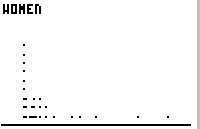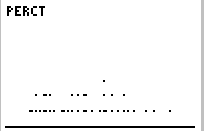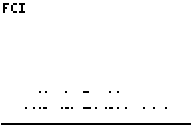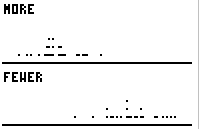Workshop Statistics: Discovery with Data, Second
Edition
Topic 2:Data, Variables, and Technology
Activity 2-1: Scrabble Names
Click here for solutions for Minitab
version.
(b)

Most of the names were 6 letters. There were a few names that were
noticeably longer, Blackwell with 9 letters and Nightingale with 11 letters.
(c)

Most of the points were
between 7 and 12, with no real peak. There are two noticeable outliers,
Nightingale with 16 points and Blackwell with 20 points.
(d) Most letters: Nightingale; Most points: Blackwell, not the same
person
(e) Fewest letters: Tukey with 5; fewest points: Gosset and Galton
with 7 points.
(f)

The ratio values are much
more evenly "spread out," ranging from 1 to 2 points/letter.
(g) The highest ratio at 2.4 belongs to Tukey. He didnít have very
many letter but some of them were pretty valuable. People like Nightingale
have lots of points but thatís not so surprising considering the number
of letters.
Note: This is the answer to (h) in the Calculator
version.
Activity 2-2: Gender of Physicians
(b) Most: internal medicine, pediatrics, family practice
Least: thoracic surgery,
aerospace medicine, colon/rectal surgery
(c) The number of physicians in each field. Sure there are a lot of
females internal medicine specialists, but there are a lot of male internal
medicine specialists as well!
(d) Highest: pediatrics, medical genetics, child psychiatry
Smallest: urological, orthopedic,
and neurological surgery
(e) The answers donít agree exactly. There are some specialties that
have a fewer number of doctors so there are a fewer number of women. However
the ratio of women can still be high. For example, there are 32, 476 females
in internal medicine, but they also have the largest number of physicians
overall. There are only 103 women in medical genetics, but thatís a huge
fraction of the 147 specialists in that field.
(f)
 OR
OR 
2000 seems to be a fairly
typical number of women, e.g. physical medicine and rehab.
(g)
 OR
OR 
A little under 25% women
seems typical, e.g. pediatric cardiology (24.2%)
(h) Emergency medicine has 3662 women but are only 17% of the overall
number in emergency medicine. Can you find a more extreme example?
(i) General preventive medicine have a small number of women (51) but
make up 33% of all specialists in this area. Again, there are numerous
combinations.
(j) Describing the dotplot: The distribution is faily "mound-shaped"
clustered around 20-25%. The highest percentage is pediatrics with 46%
women.
(k) It can be very difficult to compare "counts". Since the number
of physicians varies so much from specialty to specialty, the number of
women can be misleading if we want to know more about the gender breakdown
between the specialties, e.g. which specialities have "a lot of women"
or which specialties are women more likely to choose?
Activity 2-3: Fan Cost Index
(a) highest: N.Y. Yankees, $166.82; lowest: Montreal, $87.87
(b)
 or
or 
Most dots are between $90 and $140, with a slight majority of these
dots falling between $120 and $140. There are a few outliers, mostly
on the higher end.
(c) - (e) Answers will vary from student to student.
(f) highest: N.Y. Mets, $3.50; lowest: Philadelphia, $1.25
(g) The term "small" is relative to the ballpark. The size of
a "small" soda varies from ballpark to ballpark.
(h) highest: Boston, $0.18 per oz.; lowest: Montreal, $0.08 per
oz.
Activity 2-4: State's SAT Averages
(a) Highest average SAT: Iowa; Lowest average SAT: South Carolina
Iowa only had 5% take the
exam, S. Carolina had 61%
(c)
 or
or 
The SAT averages for states
that had more than 25% of high school seniors take the exam appears reasonably
mound shaped, centered around 1000. The SAT averages for states that had
less than 25% of high school serniors thake the exam also looks reasonly
mound shaped, but centered much higher, around 1120. In fact, there
is not much overlap between the two distributions.
One explanation could be
that in states were not a high proportion of students take the SATs, those
students that do may tend to be the college bound students and may not
represent the performance for all students in the state (especially states
that tend to use the ACT scores instead). When a higher proportion
of students take the SATs, the average will describe a much more diverse
population, lowering the overall averages for those states.
(d) A high average may not be a good indicator of how the state encourages
students to take the exam (and think about college). As more students take
the exam, itís likely this will reduce the overall average.
(e) Answers will vary from student to student.
Note: The answers to (c)-(e) above, are the answers
to (b)-(d) in the Calculator and Minitab
versions.



 OR
OR 
 OR
OR 
 or
or 
 or
or 